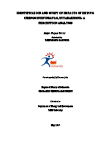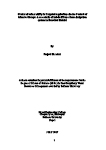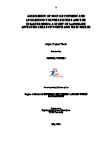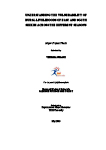Identification of Drought and Flood Induced Critical Moments and Coping Strategies in Hazard Prone Lower Teesta River Basin
Sk. Junnun Al - Hussain, Students' Dissertation, 2017
In north-western part of Bangladesh in lower Teesta basin area, people repeatedly confronted by natural catastrophe almost every year such as drought and flood. After the construction of two barrages in Gozaldoba and Dalia on Teesta river drought and flood occurs almost every year.
Identification and Study of Impacts of Drying Springs in Devprayag, Uttarakhand: A Perception Analysis
Trinayana Kaushik, Students' Dissertation, 2017
Himalayas are called the ‘third pole’ of the world and are experiencing climate change at an unprecedented rate. Various form of extreme events like flash floods, landslides, glacial lake outburst floods (GLOFs), are therefore frequently seen the Himalayan states of India. (SANDRP, 2013).
An Assessment of Potential Synergies and Conflicts in Climate Mitigation and Adaptation Policies of Nepal
Subina Shresta, Students' Dissertation, 2017
There exists an overwhelming amount of evidence that depicts human- induced climate change is taking place and it will continue to do so at rates unmatched in the recent history (Matocha et al., 2012) and that least developed countries are at the most susceptible to the risks associated with adverse climate change impacts (Parry, 2007).
Gendered vulnerability in Irrigated Agriculture in the Context of Climate Change: A case study of Labdu Dikure Shera Irrigation system in Nuwakot District
Prajjwl Bhandari, Students' Dissertation, 2017
Women are more vulnerable to climate change than men. This is because they make up the majority of the world‘s economically poor, do
most of the agricultural work , which is mostly affected by climatic variability, women bear unequal responsibility for household food security, carry a disproportionate burden for managing water and fuel for everyday survival, and rely on threatened natural resources for their livelihoods (UN, 2009). The increased male absenteeism for work outside has further increased women’s work burden.
Understanding the Governance of Micro and Mini Hydro Projects in Uttarakhand
Nithish Kanetkar, Students' Dissertation, 2017
It is evident from IPCC report(IPCC 2014) that climate change is affecting human life on the earth from all the fronts; energy(especially hydro energy), resources (forests and rivers) and livelihood are getting affected. Indian Himalayan Region spread across 12 states (ENVIS Center on Himalayan Ecology GBPIHED n.d.) is also susceptible to climate change. In these Himalayan states, more than 65% of the area is under forest cover, and it acts as a primary source of income, livelihood for millions of locals and people staying downstream (INCAA 2010); but, this study will only focus on Uttarakhand.
Irrigation System Governanace and Climate Change: Study of Panchakanya Irrigation System to Understand its Adaptive Capacity and Challenges
Krity Shresta, Students' Dissertation, 2017
The study ““Irrigation System Governance And Climate Change: Study Of Panchakanya Irrigation System To Understand Its Adaptive Capacity And Challenges” is conducted with an aim to highlight the perceived impacts of climate change in the study area i.e. Panchakanya Irrigation System (PIS), which is a Farmer managed irrigation system (FMIS) and assess the governance of the system in water resource management and assess the adaptive capacity to future climate impacts.
Assessment of Early Warning System for Floods in Uttarakhand: A Case Study Approach
Abha Nirula, Students' Dissertation, 2017
Climate change as defined by the IPCC is the “statistically significant variation in either the mean state of the climate or in its variability, persisting for an extended period (typically decades or longer)”. It leads to changes in precipitation, snow cover and cloud cover. These changes especially those relating to extreme climatic events have the ability to alter normal functioning of a community when a confluence between hazardous events and vulnerable social conditions takes place thereby resulting in a disaster.
Understanding Livelihood Impacts of Climate Change in the Upper Ganga Basin: A Case Study Approach
Yamini Yogya, Students' Dissertation, 2015
Human-induced climate change has far reaching and complex impacts on water resources throughout the world. Such impacts through water are cross-sectoral, and are felt across inherently linked sectors of agriculture, energy, ecosystems, and human health. Future climate change or change in climate parameters, such as temperature, precipitation, humidity, evapotranspiration, etc., is said to result in an increase in vulnerability of society and the environment in its capacity to adapt to such a change. Observations by National Communications (NATCOM, 2004) state that a rise in temperature has already been observed in the Indian subcontinent.
Assessment of Socio-Economic and Livelihood Vulnerabilities and the Disaster Risks: A Study of Landslide Affected Areas of North and West Sikkim
Shreya Trivedi, Students' Dissertation, 2015
SIKKIM is the least populous and the second smallest state in India. Despite its small area, it is geographically diverse due to its location in the Himalayas, with a high variation in elevation ranging from 300 to 8598 m. Mt. Kanchenjunga, the world’s third highest peak, is the guardian deity of the state. It is not only the highest but also the steepest landscape in the country, since the width of the Himalayas across its entire length is narrowest here. In terms of country-level vulnerability to climate change, India ranks high globally.
Understanding the Vulnerability of Rural Livelihoods of East and South Sikkim Across the Different Seasons
Vishaka Gulati, Students' Dissertation, 2015
Mountain ecosystems are amongst the most fragile environments on the earth and are “characterised by a high degree of poverty, fragility, marginalization and low accessibility” (Macchi et al., 2009). They are a rich source of biodiversity and also providers of many ecosystems goods and services. Major rivers in the world originate from the mountains and play a very important role in providing water to the communities living downstream. People living in the mountains are highly dependent on natural resources for their basic needs as well as livelihood and are comparatively more exposed to extreme events thereby making them even more vulnerable to the changing climate.










